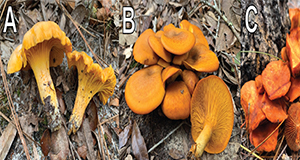Abstract
This document is intended to introduce the general public to the chanterelle mushrooms of Florida and includes a preliminary key to Florida’s most common chanterelle species. Written by Kaori Hall, Ben Lemmond, and Matthew E. Smith, and published by the UF/IFAS Plant Pathology Department, February 2023.
References
Arora, D. 1986. Mushrooms demystified. Ten Speed Press.
Bessette, A. E., A. R. Bessette, and D. P. Lewis. 2019. Mushrooms of the Gulf Coast States: A Field Guide to Texas, Louisiana, Mississippi, Alabama, and Florida. University of Texas Press. https://doi.org/10.7560/318157
Brundrett, M. C., and L. Tedersoo. 2018. "Evolutionary History of Mycorrhizal Symbioses and Global Host Plant Diversity." New Phytologist 220 (4): 1108–1115. https://doi.org/10.1111/nph.14976
Buyck, B., and V. Hofstetter. 2011. “The Contribution of tef-1 Sequences to Species Delimitation in the Cantharellus cibarius Complex in the Southeastern USA.” Fungal Diversity 49:35–46. https://doi.org/10.1007/s13225-011-0095-z
Buyck, B., V. Hofstetter, and I. Olariaga. 2016. “Setting the Record Straight on North American Cantharellus.” Cryptogamie Mycologie 37 (3): 405–417. https://doi.org/10.7872/crym/v37.iss3.2016.405
Buyck, B., P. A. Moreau, R. Courtecuisse, A. Kong, M. Roy, and V. Hofstetter. 2016. “Cantharellus coccolobae sp. nov. and Cantharellus garnieri, Two Tropical Members of Cantharellus subg. Cinnabarinus.” Cryptogamie Mycologie 37 (3): 391–403. https://doi.org/10.7872/crym/v37.iss3.2016.391
Foltz, M. J., K. E. Perez, and T. J. Volk. 2013. “Molecular phylogeny and morphology reveal three new species of Cantharellus within 20 m of one another in western Wisconsin, USA.” Mycologia 105 (2): 447–461.
Leacock, P. R., J. Riddell, A. W. Wilson, R. Zhang, C. Ning, and G.M. Mueller. 2016. “Cantharellus chicagoensis sp. nov. is supported by molecular and morphological analysis as a new yellow chanterelle in midwestern United States.” Mycologia 108 (4): 765–772.
Pilz, D., L. Norvell, E. Danell, and R. Molina. 2003. Ecology and Management of Commercially Harvested Chanterelle Mushrooms. United States Department of Agriculture, Forest Service, Pacific Northwest Research Station. General Technical Report PNW-GTR-576. https://doi.org/10.2737/PNW-GTR-576
Tedersoo, L., M. Bahram, S. Põlme, U. Kõljalg, N. S. Yorou, R. Wijesundera, L. V. Ruiz, A. M. Vasco-Palacios, P. Q. Thu, A. Suija, M. E. Smith, C. Sharp, E. Saluveer, A. Saitta, M. Rosas, T. Riit, D. Ratkowsky, K. Pritsch, K. Põldmaa, M. Piepenbring, … and K. Abarenkov. 2014. “Global Diversity and Geography of Soil Fungi.” Science 346 (6213): 1256688. https://doi.org/10.1126/science.1256688
Thorn, R. G., J. I. Kim, R. Lebeuf, and A. Voitk. 2017. “The Golden Chanterelles of Newfoundland and Labrador: A New Species, a New Record for North America, and a Lost Species Rediscovered.” Botany 95 (6): 547–560. https://doi.org/10.1139/cjb-2016-0213
Vanden Hoek, T. L., T. Erickson, D. Hryhorczuk, and K. Narasimhan. 1991. “Jack O’Lantern Mushroom Poisoning.” Annals of Emergency Medicine 20 (5): 559–561. https://doi.org/10.1016/S0196-0644(05)81617-8

